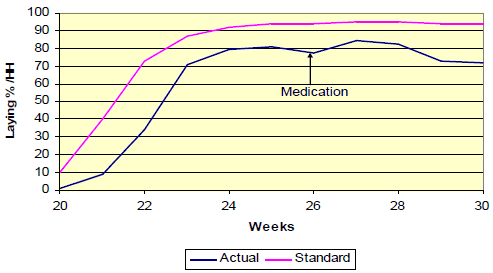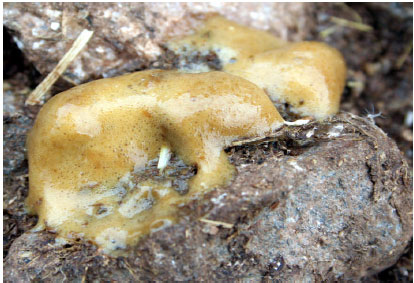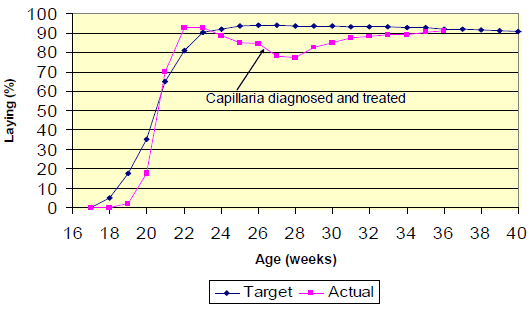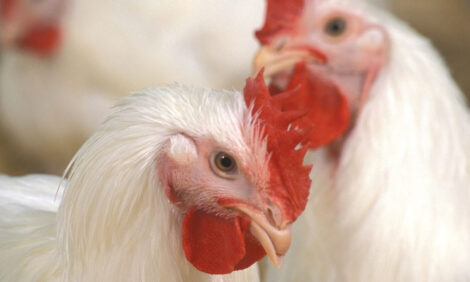



Egg Drops – Less a Syndrome, More a Production Failure
Egg drops appear to be an integral part of egg production, according to David Burch of Octagon Services. He describes the main causes and recommends ways to minimise the resulting losses.Egg Drop Syndrome was used to describe the effects of a virus that infected flocks back in the 1970s. Falls in egg production could be as much as 40 per cent but were more commonly 10-15 per cent. In present day, layer production ‘egg drops’ or reduced egg production are frequently an indication that something in the system has gone wrong and the flock is showing the farmer that he needs to pay attention to their management, health and welfare to solve the problem and restore production. The difficulties arise when you have to work out which part of the system is failing.
Normal Production
Using normal production targets from a commercial laying hen provider in intensive (cages) and alternative (barn and free range) systems, similar target figures are achievable but with cages being generally more productive (see Table 1).
| Table 1. Target production figures for commercial laying hens in intensive and alternative production systems | |||
| Parameter | Intensive | Alternative | Difference (%) |
|---|---|---|---|
| Body weight at 18 weeks (kg) | 1.5 | 1.5 | - |
| Bodyweight at 72 weeks (kg) | 1.96 | 1.94 | - |
| Age at 50% production (wks) | 20 | 21.5 | - |
| Age at peak production (wks) | 26 | 27 | - |
| Peak production (%) | 94-96 | 93-95 | -1.0 |
| Hen-day eggs to 72 weeks | 323 | 315 | -2.5 |
| Hen-housed eggs to 72 weeks | 318 | 309 | -2.8 |
| Liveability 16-80 weeks (%) | 96 | 95 | -1.0 |
| Mortality 18-72 weeks (%) | 3.2 | 3.8 | 0.6 |
| Total egg mass 18-72 weeks (kg) | 20.5 | 20 | -2.4 |
| Average daily feed consumption (g) | 114 | 115-125 (B) 125-135 (FR) |
5.3 (120) 14.0 (130) |
| Feed consumption weeks 21-72 (kg) | 40.7 | 42.8 (B) 46.4 (FR) |
5.2 14.0 |
| Feed / Egg conversion weeks 21-72 | 2.05 | Ave 2.14 (B) Ave 2.32 (FR) |
4.2 11.6 |
| Feed / dozen eggs (kg) weeks 21-72 | 1.57 | ||
| Key: B = Barn; FR = Free range | |||
The production of eggs per hen housed (HH) initially is one of the most important parameters as it incorporates egg production with hen mortality as well. These are two of the basic parameters that are important for monitoring house/flock productivity. Both of these parameters can be damaged by disease. The production cycle is long, over a year, so again if there is a poor start it is difficult to get good production out of a flock.
In a recent survey, a target production of 315 eggs per HH in caged flocks and only 285 eggs per HH in free-range flocks was used. This showed a reduction of 9.5 per cent in eggs produced in free-range systems and the mortality is usually about 10 per cent or more, which is much higher than target of four per cent. Free-range flocks have their own production problems in the UK, as will be discussed later. Barn flocks, although not as popular as free-range here, do appear to run two per cent less efficiently than caged flocks.
Fortunately, the price for free-range eggs is higher than caged birds and the income/hen is higher. Based on recent egg prices, an average free-range hen’s income would be about £22.57 in comparison with £16.07, but feed (approx. £180/tonne) and labour costs/hen are higher for free-range systems.
Major Causes of Egg Drop
From an infectious point of view, Egg Drops can be divided into a number of causal categories, mainly viral, bacterial/mycoplasmal or parasitic (see Table 2).
| Table 2. Common infectious causes of egg drop | ||
| Agent | Abbreviation | Comment |
|---|---|---|
| VIRAL AGENTS | ||
| Egg drop syndrome | EDS | Up to 40 per cent drop initially, usually 10-15 per cent drop – egg shall quality also affected |
| Infectious bronchitis | IB | Respiratory disease (head shaking) egg drops, erratic production – affects shell quality and colour and egg quality. Variant strains. Often associated with Mycoplasma and secondary E. coli septicaemia |
| Infectious laryngo-tracheitis | ILT | Respiratory infection, variable severity/mortality with strain differences. Problem on multi-age sites |
| Infectious avian encephalitis | IAE | No clinical signs in adults; may cause 5 per cent drop in egg production |
| Infectious bursal disease | IBD | Mainly affects replacement pullets - mortality |
| Avian metapneumovirus/rhinotracheitis | ART | Respiratory infection, lung & air sac lesions, depressed egg production |
| Marek’s disease | MD | Lymphoid tumours of ovary, lung, heart, liver kidney and spleen. Swollen nerves and paralysis affects birds 12-25 weeks of age. |
| Avian influenza (Fowl plague) | AI | Mild depression and respiratory signs, egg production drops. Severe forms – highly pathogenic - high mortality – Notifiable |
| Newcastle disease | ND | Variable severity, respiratory disease plus neurological signs and green diarrhoea – drops in egg production and soft shelled eggs - Notifiable |
| BACTRIAL / MYCOPLASMAL | ||
| Mycoplasma synoviae | MS | Widespread, 70 per cent of UK flocks. Generally thought to have minor effect but some strains might be more pathogenic. Associated with 1-3 per cent egg drop, mainly in early laying, may increase colibacillosis incidence. Can cause airsacculitis and synovitis or lameness. Egg shell abnormalities recently described in Netherlands |
| Mycoplasma gallisepticum | MG | Less common, occasional outbreaks, cause 20 per cent drops in egg production but normally chronic form about 5 per cent, Causes respiratory problems and secondary E. coli infections |
| Escherichia coli | EC | Can cause depressed production near peak, associated with some serotypes. Usually associated with ascending reproductive tract infections such as salpingitis, egg peritonitis or secondary to IB & MG. |
| Pasteurella multocida (Fowl cholera) |
PM | Septicaemic condition in layers affecting joints and causing peritonitis, Acute form causes high mortality and can develop into a chronic form. |
| Staphylococcus aureus | SA | Potentially another septicaemic condition but usually causes tenosynovitis, arthritis and lameness |
| Erysipelothrix rhusiopathiae (Erysipelas) |
ER | A septicaemic condition which causes mortality and drops in egg production. May be associated with rats. |
| Avian vibrionic hepatitis spotty liver disease) |
AVH | Thought to be caused by Campylobacter but difficult to reproduce. Classical micro-abscesses on liver. Can cause mortality and marked drops in egg production (30 per cent). |
| Avian intestinal spirochaetosis | AIS | Caused by Brachyspira infections, mainly B. intermedia and B. pilosicoli. Recent work suggests in free-range flocks, B. innocens and B. murdochii may also be problematic and 90 per cent of free-range flocks are infected. Causes chronic diarrhoea (brown and frothy caecal droppings), a 5-10 per cent drop in egg production and increased mortality up to 8 per cent. Suspected to be the major cause of poor production in UK free-range flocks. |
| Salmonella enterica spp | SE | S. Enteritidis and Typhimurium may be found in poultry but may not always be pathogenic in older birds. Vaccination is required to prevent transmission to man where they can cause severe enteric diseases. S. Pullorum and S. Gallinarum may occasionally be found, the cause of ‘pullorum disease’ and ‘fowl typhoid’ or ‘bacillary white diarrhoea’. Wild birds are potential reservoirs. |
| Necrotic enteritis | NE | Caused by Clostridium perfringens causes characteristic lesions in the small intestine and may be associated with coccidiosis. It is usually seen in younger birds but can affect replacement pullets & adult birds reared on the floor. |
| PARASITES | ||
| Coccidiosis (Eimeria spp) |
CC | Most pullets are vaccinated or immunity is allowed to build up by the use of coccidiostats before point of lay but it is possible in free range flocks for coccidiosis to strike. |
| Red Mite | RM | Dermanyssus gallinae is still an important cause of chronic depression of production in many flocks. It can affect free-range and caged flocks and hygiene and chemical control are important. |
| Roundworms | RW | Ascarids are the most common worms and can cause a chronic drop in egg production if untreated. They affect mainly free-range flocks: in a small survey, 30 per cent were infected. Other worms such as Capillaria, the threadworm and Heterakis, the caecal worm can also be found, carries Histomonas |
| Histomonas meleagridis (Blackhead) |
HM | Although mainly associated with turkeys, occasional cases occur in free-range flocks causing an increase in mortality and depression in egg production by 20 per cent for several weeks until flock immunity builds up. |
With all these infections, if a bird becomes ill, the feed intake drops. They are under a tremendous metabolic stress, due to producing an egg almost every day, so that one of the first clinical signs, if there is a problem, is a drop in egg production.
Preparation of the Pullet
Since working in the industry, the author says he has always been impressed by the preparation of the pullet within a 15- to 16-week period to rear it to a suitable weight (approx 1.35kg ±10 per cent at 16 weeks) but at the same time, having to vaccinate her against a range of diseases and prepare for her life ahead either in cages, barns or free-range – hopefully, free of disease for the next 56 weeks.
An example of a vaccination programme for pullets is shown in Table 3. Most of the viral diseases are vaccinated against. MD and IBD are usually given at the hatchery. IB is given a number of times, to include the variants as well and then boosted with a killed vaccine just before placement. If birds come from a potentially MG infected source they should be blood tested to check and vaccinated, or especially, if they are going to an infected multi-age site. Coccidiosis vaccine is given usually in the first week and the current vaccines protect against the eight most common Eimeria species. It is a very busy vaccination schedule and additional ones can be incorporated where specific diseases have been identified as a major problem in the past.
| Table 3. Example of a routine vaccination programme for a pullet | ||||||||||||||
| Week | 0 | 1 | 2 | 3 | 4 | 5 | 6 | 7 | 8 | 9 | 10 | 11 | 12 | 13 |
|---|---|---|---|---|---|---|---|---|---|---|---|---|---|---|
| MD | L | K | ||||||||||||
| IBD | L | L | ||||||||||||
| SE | L | L | ||||||||||||
| IB | LL | LL | LLL | KK | ||||||||||
| MG | BS | (L) | ||||||||||||
| ILT | L | |||||||||||||
| AE | L | |||||||||||||
| ART | L | K | ||||||||||||
| ND | L | K | ||||||||||||
| EDS | K | |||||||||||||
| CC | L | |||||||||||||
| Key: L = live vaccine; K = killed vaccine; BS = Blood sample, vaccinate if positive; MD = Marek’s disease; IBD = Infectious bursal (Gumboro) disease; SE = Salmonella enterica Enteritidis; IB = Infectious bronchitis + variants; MG = Mycoplasma gallisepticum; ILT = Infectious laryngo-tracheitis; AE = Avian encephalitis; ART = Avian rhinotracheitis; ND = Newcastle disease; EDS = Egg drop syndrome; CC = Coccidiosis | ||||||||||||||
The objective of the vaccination programme is to have an immune bird at 16 weeks of age weighing about 1.35kg ±10 per cent (limited variation) so that it is big and mature enough to start laying at around the 18 to 20 weeks of age.
The Laying Bird
Preparation of housing for the birds is very important. Cages should be cleaned and disinfected between flocks, although sometimes it is difficult in deep pit houses. Mite control is also an important consideration. Fly and rodent control programmes should be put in place during production. Barns can be thoroughly cleaned but on free-range farms, it is often difficult to do too much to the range, other than repair damaged or worn areas near the houses and reduce the potential for puddles to form.
Blood samples taken at point of lay are usually held in the event that a problem subsequently develops. They are very useful to check firstly if vaccination was effective and also, if there is an infectious challenge later, antibody titres can be compared and the likely cause identified.
Laying production, body weight, mortality and feed intake are usually well monitored so that production problems can be identified early on.
An example of a flock’s production with variant IB 793B is shown in Figure 1. The birds came in underweight and started to lay late. They never reached their peak production (-15 per cent) and remained below standard by 10 to 20 per cent, in spite of antibiotic medication.

In free-range flocks in particular, Brachyspira appear to be a major problem. Normally, B. pilosicoli and B. intermedia are thought to be pathogenic but recently B. innocens has been demonstrated to cause a similar problem. The infection is not usually as acute as B. intermedia but although the flock reached peak production, it steadily declined in performance until there was nearly a 20 per cent drop in production prior to treatment. This is a result of chronic diarrhoea, debilitating the hen and its performance. Diarrhoea (brown frothy droppings – see Photo1) can be found in 80 per cent of faeces samples in severe cases.

It is difficult to control most enteric diseases in free-range flocks, as they like to go out and drink from puddles, which may be contaminated and facilitates the spread of the disease (see Photo 2).


Worms are also a common cause of egg drop or poor production in free-range flocks. In a small survey, the author found 30 per cent of free-range flocks production were affected by worms. Figure 3 demonstrates the effect of Capillaria, the fine thread worm, causing a 17 per cent drop in egg production.

Controlling Layer Infections
There are very limited options for treating laying hens, due to the relatively few antibiotics that have a zero withdrawal period for eggs. Currently, only tiamulin (Denagard, Novartis Animal Health) and tylosin (Tylan, Elanco) are licensed in the UK for layers, following the recent withdrawal of chlortetracycline but colistin is available, imported under cascade from Europe, all for use via the drinking water. Chlortetracycline had a broad activity against Mycoplasma, Pasteurella, Salmonella and to a lesser extent E. coli. Colistin is excellent against E. coli and Salmonella> but only active in the gut. Tiamulin and tylosin are highly active against Mycoplasma and tiamulin is widely used against Brachyspira, as tylosin appears to have some resistance problems. Tylosin is active against clostridia, which usually cause enteric problems in younger birds. Other antimicrobial products may be used but eggs should be discarded during treatment and for the standard withdrawal period afterwards. The veterinarian should be consulted with regard to all these matters as antibiotics are prescription-only medicines (POM-V).
Flubendazole (Flubenvet, Janssen) is widely used for treating intestinal worms in hens via the feed and also has a zero withholding time for eggs; it is a POM-VPS product so will need a prescription.
Conclusions
Egg Drops appear to be an integral part of egg production.
Maintaining good farm biosecurity, avoiding multi-age sites where possible, good vaccination programmes for the pullets and prompt attention to egg drops all seem to be important parts in minimising resulting losses.
Free-range production has its own problems and issues and in many ways it is surprising that the system provides 35 per cent of the UK eggs that are produced. However, with the future changes in cage production scheduled for 2012, it is possible they may increase even further.
This article was originally published in 'Pig and Poultry Marketing'
November 2009








